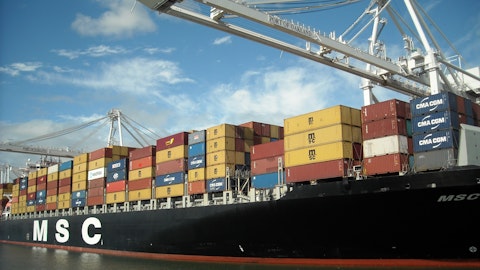With respect to the down payment that we intend to make per delivery of the vessels, we will be making $350 million worth of down payments in 2024 when we take the deliveries of 15 7,000 TEU ship for which we agreed to pay $20 million per ship upfront, and the remainder of the 15,000 TEU ships for which we are committed to paying [$13 million] (ph). So precisely, it’s $300 million plus $39 million, $339 million of upfront payments that we will be making in 2024, after having been — having made, sorry, in 2023 close to $140 million. Depreciation going forward is going to be impacted by the impairment, as I mentioned earlier on. So, the situation or the model that you had pre-impairment, I did guide that the fourth quarter, the effect of the impairment would be a little bit in excess of $150 million.
So, you should assume that for the full year of next year, it will be slightly above $600 million in terms of overall impact versus the prior model, without impairment being registered in the third quarter. And in terms of cash payment or lease liability repayment, there should be no difference between the situation before impairment or after impairment, as [Technical Difficulty] on balance sheet is today unchanged as a result of the impairment, that only reduced our fixed asset base.
Alexia Dogani: Understood. Thank you.
Operator: Your next question comes from the line of Patrick Creuset from Goldman Sachs. Please go ahead.
Patrick Creuset: Hey, Eli and Xavier. It looks like you managed to limit the cash burn somewhat in the third quarter. And as we just start with the lease payments, looks like they’re down $100 million quarter-on-quarter. Just trying to understand what’s driving that. I mean, how much of that is coming from the redelivery of about 20 vessels? How much of it is maybe down to sort of one-off timing effects and perhaps also some costs flowing back above EBITDA? I remember with the extension of the duration of some of these charters has been just transferred from above EBITDA to below EBITDA in some of these payments. And then related to that, net-net between redeliveries and new vessels next year, what do you think is the right quarterly run rate on these charter payments, I mean, from this sort of $350 million level in the third quarter?
Xavier Destriau: Thank you, Patrick. So, you’re right that there’s been some of a timing effect in the third quarter that I will explain. Nothing has changed in terms of the reallocation of cost between above EBITDA or below, no. All of our vessel costs today, or 99% of our vessel costs today, still are being registered in — again, [indiscernible] effect of the impairment in depreciation and amortization. From a cash perspective, if we look at the third quarter, what happened in our lease liability timing repayment, what are our lease liabilities is mainly the charter that we pay back to the vessel owner. The payments are made every two weeks, that’s the way it works in the chartering market, the first of the month and the 15th of the month.
And if the first of the month is or isn’t a banking day, then the payments are being pushed or delayed. So, we had one payment run less in Q3 compared to Q2. So, we had five out of six that contributed to $100 million less payments versus the prior quarter. So that’s just one timing effect. We also had a positive impact in our third quarter of working capital improvement, mainly driven by less receivable on the balance sheet. That also contributed to increasing our cash flow from operation. This is going to be most probably a one-off, hopefully, because this is the result of the lower freight rates that we are able to [indiscernible] to our customer.
Patrick Creuset: Okay. I mean, you’ve preempted my follow-up question there on the working capital. So sounds like you don’t see more opportunities to optimize working capital. Do you think that’s the [indiscernible] at the nine months?
Xavier Destriau: I think we’ve made some very good progress here. I mean, leave aside the fact that the value of the receivables are less, which is something that we are not too happy about. But in terms of collection efforts and past due, we are at a very low level. So our DSO is quite good. So we are pleased on that front. So this is why I’m saying that we should not expect unless there is a continued deterioration in the freight rate environment of a significant working capital improvement. On the AP side, we are maintaining pretty much the payment terms that we have agreed with our supplier base.
Patrick Creuset: Got it. And then, last one. Can you just give a quick update on how you see the Panama Canal situation evolving and how you are adapting your operations to it? I mean, I guess you run probably slightly lower utilization, maybe get slightly higher rates. But any color on how you’re rerouting and then adapting be interesting. Thank you.
Xavier Destriau: It is true that the Panama Canal is a worrisome situation and evolving day after day with the draft limitation that is being imposed on the industry. So, we do operate a few, a number of services that go through the Panama Canal, namely our Asia-U.S. East Cost Service, ZCP, and also our new service to Baltimore, ZXB service. So, we are trying to optimize the utilization of the ship given the draft limitation, and the draft limitation imposed mainly on the weight of the cargo that we’re carrying. And we’re also taking actions to utilize our feedering service in Latin America to discharge some cargo before the Panama Canal and so that the vessel can run full across the Pacific before it has to cross the canal.



